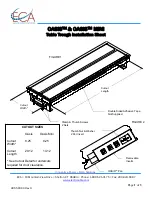
13
GB/IE
The device is particularly suitable for training
the upper body and arm muscles, and improves
overall endurance and fat burning.
Please note that the training equipment corre-
sponds to EN 957-2 class H (H = Home use).
The maximum weight is 10.5 kg. According to
DIN EN ISO 20957-1, the training item is not
suited for teenagers below 14 years of age.
Parents and other supervisors should be aware
of their responsibility, because due to the chil-
dren’s natural play instinct and their joy at ex-
perimenting they may get into situations and
show behaviour for which the training equipment
is not suitable.
If you allow children to use the equipment you
should take their mental and physical develop-
ment and above all their liveliness into consid-
eration. You should supervise the children and
above all show them how to use the equipment
correctly. Training equipment by no means is
suitable as toy.
Assembly
Insert the weight plates
2
onto the dumbbell
bar
1
(Fig. B). Ensure the weights at both ends
of the dumbbell bar
1
are equal to avoid injury.
You can add or remove the provided weight
plates
2
based on your own ability.
For secure the weight plates
2
, compress the
grips of closure
3
and insert it (with the grips
facing outwards) onto the dumbbell bar
1
(Fig, C). Make sure the weight plates
2
are
secured tightly. Figure D shows the complete
assembled product.
Training notes
With your interest in strength training you have taken
a step towards mobility and health, because strength
training strengthens your muscles. In addition, the
mobility of your joints is increased, which can reduce
the risk of injury. Your cholesterol, your blood pres-
sure, your blood sugar, your motivation, your body
fat percentage and your mood can be improved by
the sport in conjunction with the right diet.
General training notes
Each exercise should consist of the following three
parts:
1. Warm Up
2. Cardio or weight exercise
3. Cool Down and stretching
Warm Up
This phase helps reduce the risk of muscle injury and
cramping by increasing blood flow and preparing
muscles for training. It is advisable to do a few
stretching exercises for approximately 30 seconds.
Do not overstrain your muscles and avoid jerky
movements. If it hurts, STOP.
The Training
Endurance (often also called cardiovascular or car-
dio training because of the positive effects on the car-
diovascular system) or a strength or muscle training
is the first step in the fight against many civilization
diseases, especially those that occur with increas-
ing age. It can also boost the immune system and
prevent infectious diseases.
Cool Down
Just as a warm-up should be performed before each
training session, a cool-down should take place af-
ter a unit. A Cool Down starts the relaxation phase;
the operating temperature of the body will come
back down and shows the transition of stress relax-
ation. The cool-down should last at least 10 minutes
(as the Warm Up) and is controlled slowly dropping
down to the lowest level. The pulse rate should drop
as low as possible.
Stretching
After the training you should definitely stretch your
muscles. You can either stretch before or during the
exercise to warm up your muscles easily. A stretch-
ing afterwards returns the muscle to its original length,
thus preventing muscle shortening. The more vigor-
ous the training has been, the more important is the
stretching afterwards. Stretching should take 20 to
30 seconds per muscle. Stretching should be notice-
able for the muscle addressed, but it should never
hurt.














































